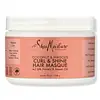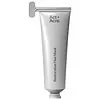What's inside
What's inside
 Key Ingredients
Key Ingredients

 Benefits
Benefits

 Concerns
Concerns

 Ingredients Side-by-side
Ingredients Side-by-side

Water
Skin ConditioningCetearyl Alcohol
EmollientCaprylic/Capric Triglyceride
MaskingGlycerin
HumectantButyrospermum Parkii Butter
Skin ConditioningStearyl Alcohol
EmollientCetyl Alcohol
EmollientBehentrimonium Methosulfate
Cocos Nucifera Oil
MaskingPanthenol
Skin ConditioningBehentrimonium Chloride
PreservativeCocos Nucifera Fruit Juice
EmollientHydroxyethylcellulose
Emulsion StabilisingSodium Benzoate
MaskingMelia Azadirachta Seed Oil
EmollientArgania Spinosa Kernel Oil
EmollientHibiscus Rosa-Sinensis Flower Extract
HumectantTocopherol
AntioxidantHydrolyzed Soy Protein
HumectantTriethyl Citrate
MaskingCaprylyl Glycol
EmollientBenzoic Acid
MaskingParfum
MaskingWater, Cetearyl Alcohol, Caprylic/Capric Triglyceride, Glycerin, Butyrospermum Parkii Butter, Stearyl Alcohol, Cetyl Alcohol, Behentrimonium Methosulfate, Cocos Nucifera Oil, Panthenol, Behentrimonium Chloride, Cocos Nucifera Fruit Juice, Hydroxyethylcellulose, Sodium Benzoate, Melia Azadirachta Seed Oil, Argania Spinosa Kernel Oil, Hibiscus Rosa-Sinensis Flower Extract, Tocopherol, Hydrolyzed Soy Protein, Triethyl Citrate, Caprylyl Glycol, Benzoic Acid, Parfum
Water
Skin ConditioningCetearyl Alcohol
EmollientIsoamyl Laurate
EmollientHydrogenated Castor Oil/Sebacic Acid Copolymer
EmollientGlycerin
HumectantDiheptyl Succinate
EmollientTriethyl Citrate
MaskingArachidyl Alcohol
EmollientDi-C12-15 Alkyl Fumarate
EmollientBehentrimonium Methosulfate
C12-15 Alkyl Benzoate
AntimicrobialCaprylic/Capric Triglyceride
MaskingBehenyl Alcohol
EmollientPhenoxyethanol
PreservativeBehentrimonium Chloride
PreservativeCetrimonium Chloride
AntimicrobialPanthenol
Skin ConditioningGuar Hydroxypropyltrimonium Chloride
Skin ConditioningHydrogenated Vegetable Oil
EmollientSclerotium Gum
Emulsion StabilisingArachidyl Glucoside
EmulsifyingCeteareth-20
CleansingHydroxyethylcellulose
Emulsion StabilisingButyrospermum Parkii Butter
Skin ConditioningRicinus Communis Seed Oil
MaskingOryza Sativa Bran Extract
Skin ConditioningIsopropyl Alcohol
SolventCaprylyl Glycol
EmollientTocopheryl Acetate
AntioxidantTetrasodium Glutamate Diacetate
Ethylhexylglycerin
Skin ConditioningHydrolyzed Vegetable Protein
Skin ConditioningJuniperus Virginiana Oil
MaskingHelianthus Annuus Extract
EmollientCapryloyl Glycerin/Sebacic Acid Copolymer
Skin ConditioningCitric Acid
BufferingRosmarinus Officinalis Leaf Extract
AntimicrobialTocopherol
AntioxidantPogostemon Cablin Leaf Oil
MaskingGamma-Nonalactone
MaskingIonone
AstringentAmyris Balsamifera Bark Oil
MaskingSodium Acetate
BufferingPotassium Sorbate
PreservativeSodium Benzoate
MaskingCellulose
AbsorbentCananga Odorata Flower Oil
MaskingDimethylheptenal
PerfumingHexenyl Acetate
MaskingElettaria Cardamomum Seed Oil
MaskingViola Odorata Flower/Leaf Extract
MaskingCistus Ladaniferus Leaf/Stem Extract
MaskingAquilaria Agallocha Wood Oil
MaskingVanillin
MaskingSodium Hydroxide
BufferingSodium Glycolate
BufferingSodium Formate
BufferingWater, Cetearyl Alcohol, Isoamyl Laurate, Hydrogenated Castor Oil/Sebacic Acid Copolymer, Glycerin, Diheptyl Succinate, Triethyl Citrate, Arachidyl Alcohol, Di-C12-15 Alkyl Fumarate, Behentrimonium Methosulfate, C12-15 Alkyl Benzoate, Caprylic/Capric Triglyceride, Behenyl Alcohol, Phenoxyethanol, Behentrimonium Chloride, Cetrimonium Chloride, Panthenol, Guar Hydroxypropyltrimonium Chloride, Hydrogenated Vegetable Oil, Sclerotium Gum, Arachidyl Glucoside, Ceteareth-20, Hydroxyethylcellulose, Butyrospermum Parkii Butter, Ricinus Communis Seed Oil, Oryza Sativa Bran Extract, Isopropyl Alcohol, Caprylyl Glycol, Tocopheryl Acetate, Tetrasodium Glutamate Diacetate, Ethylhexylglycerin, Hydrolyzed Vegetable Protein, Juniperus Virginiana Oil, Helianthus Annuus Extract, Capryloyl Glycerin/Sebacic Acid Copolymer, Citric Acid, Rosmarinus Officinalis Leaf Extract, Tocopherol, Pogostemon Cablin Leaf Oil, Gamma-Nonalactone, Ionone, Amyris Balsamifera Bark Oil, Sodium Acetate, Potassium Sorbate, Sodium Benzoate, Cellulose, Cananga Odorata Flower Oil, Dimethylheptenal, Hexenyl Acetate, Elettaria Cardamomum Seed Oil, Viola Odorata Flower/Leaf Extract, Cistus Ladaniferus Leaf/Stem Extract, Aquilaria Agallocha Wood Oil, Vanillin, Sodium Hydroxide, Sodium Glycolate, Sodium Formate
Ingredients Explained
These ingredients are found in both products.
Ingredients higher up in an ingredient list are typically present in a larger amount.
This ingredient is a preservative and often used for it's anti-static properties. You'll most likely see this ingredient in hair conditioners.
It does not cause irritation or sensitization in leave-on products at 1-5%.
Behentrimonium Methosulfate is an ammonium salt. It is mainly used to prevent static in haircare products as a surfactant.
Surfactants have differing ends: one side is hydrophilic while the other end is hydrophobic.
Surfactants also help your cleansers remove pollutants more easily from the skin.
Learn more about Behentrimonium MethosulfateThis ingredient is also known as shea butter. It is an effective skin hydrator and emollient.
Emollients help soothe and soften your skin. It does this by creating a protective film on your skin. This barrier helps trap moisture and keeps your skin hydrated. Emollients may be effective at treating dry or itchy skin.
Shea butter is rich in antioxidants. Antioxidants help fight free-radicals, or molecules that may harm the body. It is also full of fatty acids including stearic acid and linoleic acid. These acids help replenish the skin and keep skin moisturized.
While Shea Butter has an SPF rating of about 3-4, it is not a sunscreen replacement.
Shea butter may not be fungal acne safe. We recommend speaking with a professional if you have any concerns.
Learn more about Butyrospermum Parkii ButterThis ingredient is an emollient, solvent, and texture enhancer. It is considered a skin-softener by helping the skin prevent moisture loss.
It helps thicken a product's formula and makes it easier to spread by dissolving clumping compounds.
Caprylic Triglyceride is made by combining glycerin with coconut oil, forming a clear liquid.
While there is an assumption Caprylic Triglyceride can clog pores due to it being derived from coconut oil, there is no research supporting this.
Learn more about Caprylic/Capric TriglycerideCaprylyl Glycol is a humectant and emollient, meaning it attracts and preserves moisture.
It is a common ingredient in many products, especially those designed to hydrate skin. The primary benefits are retaining moisture, skin softening, and promoting a healthy skin barrier.
Though Caprylyl Glycol is an alcohol derived from fatty acids, it is not the kind that can dry out skin.
This ingredient is also used as a preservative to extend the life of products. It has slight antimicrobial properties.
Learn more about Caprylyl GlycolCetearyl alcohol is a mixture of two fatty alcohols: cetyl alcohol and stearyl alcohol. It is mainly used as an emulsifier. Emulsifiers help prevent the separation of oils and products. Due to its composition, it can also be used to thicken a product or help create foam.
Cetearyl alcohol is an emollient. Emollients help soothe and hydrate the skin by trapping moisture.
Studies show Cetearyl alcohol is non-toxic and non-irritating. The FDA allows products labeled "alcohol-free" to have fatty alcohols.
This ingredient is usually derived from plant oils such as palm, vegetable, or coconut oils. There is debate on whether this ingredient will cause acne.
Due to the fatty acid base, this ingredient may not be Malassezia folliculitis safe.
Learn more about Cetearyl AlcoholGlycerin is already naturally found in your skin. It helps moisturize and protect your skin.
A study from 2016 found glycerin to be more effective as a humectant than AHAs and hyaluronic acid.
As a humectant, it helps the skin stay hydrated by pulling moisture to your skin. The low molecular weight of glycerin allows it to pull moisture into the deeper layers of your skin.
Hydrated skin improves your skin barrier; Your skin barrier helps protect against irritants and bacteria.
Glycerin has also been found to have antimicrobial and antiviral properties. Due to these properties, glycerin is often used in wound and burn treatments.
In cosmetics, glycerin is usually derived from plants such as soybean or palm. However, it can also be sourced from animals, such as tallow or animal fat.
This ingredient is organic, colorless, odorless, and non-toxic.
Glycerin is the name for this ingredient in American English. British English uses Glycerol/Glycerine.
Learn more about GlycerinHydroxyethylcellulose is used to improve the texture of products. It is created from a chemical reaction involving ethylene oxide and alkali-cellulose. Cellulose is a sugar found in plant cell walls and help give plants structure.
This ingredient helps stabilize products by preventing ingredients from separating. It can also help thicken the texture of a product.
This ingredient can also be found in pill medicines to help our bodies digest other ingredients.
Learn more about HydroxyethylcellulosePanthenol is a common ingredient that helps hydrate and soothe the skin. It is found naturally in our skin and hair.
There are two forms of panthenol: D and L.
D-panthenol is also known as dexpanthenol. Most cosmetics use dexpanthenol or a mixture of D and L-panthenol.
Panthenol is famous due to its ability to go deeper into the skin's layers. Using this ingredient has numerous pros (and no cons):
Like hyaluronic acid, panthenol is a humectant. Humectants are able to bind and hold large amounts of water to keep skin hydrated.
This ingredient works well for wound healing. It works by increasing tissue in the wound and helps close open wounds.
Once oxidized, panthenol converts to pantothenic acid. Panthothenic acid is found in all living cells.
This ingredient is also referred to as pro-vitamin B5.
Learn more about PanthenolSodium Benzoate is a preservative. It's used in both cosmetic and food products to inhibit the growth of mold and bacteria. It is typically produced synthetically.
Both the US FDA and EU Health Committee have approved the use of sodium benzoate. In the US, levels of 0.1% (of the total product) are allowed.
Sodium benzoate works as a preservative by inhibiting the growth of bacteria inside of cells. It prevents the cell from fermenting a type of sugar using an enzyme called phosphofructokinase.
It is the salt of benzoic acid. Foods containing sodium benzoate include soda, salad dressings, condiments, fruit juices, wines, and snack foods.
Studies for using ascorbic acid and sodium benzoate in cosmetics are lacking, especially in skincare routines with multiple steps.
We always recommend speaking with a professional, such as a dermatologist, if you have any concerns.
Learn more about Sodium BenzoateTocopherol (also known as Vitamin E) is a common antioxidant used to help protect the skin from free-radicals and strengthen the skin barrier. It's also fat soluble - this means our skin is great at absorbing it.
Vitamin E also helps keep your natural skin lipids healthy. Your lipid skin barrier naturally consists of lipids, ceramides, and fatty acids. Vitamin E offers extra protection for your skin’s lipid barrier, keeping your skin healthy and nourished.
Another benefit is a bit of UV protection. Vitamin E helps reduce the damage caused by UVB rays. (It should not replace your sunscreen). Combining it with Vitamin C can decrease sunburned cells and hyperpigmentation after UV exposure.
You might have noticed Vitamin E + C often paired together. This is because it is great at stabilizing Vitamin C. Using the two together helps increase the effectiveness of both ingredients.
There are often claims that Vitamin E can reduce/prevent scarring, but these claims haven't been confirmed by scientific research.
Learn more about TocopherolTriethyl Citrate comes from citric acid. It has masking, perfuming, and solvent properties. As a solvent, this ingredient helps disperse ingredients evenly in skincare.
One manufacturer claims this ingredient can:
According to perfume manufacturers, this ingredient is almost odorless but has a mild fruity, wine and plum scent. It can be used to mask the scent of other ingredients.
This ingredient can be plant-sourced or synthetic; it can naturally be found in cabbage and white wine.
Learn more about Triethyl CitrateWater. It's the most common cosmetic ingredient of all. You'll usually see it at the top of ingredient lists, meaning that it makes up the largest part of the product.
So why is it so popular? Water most often acts as a solvent - this means that it helps dissolve other ingredients into the formulation.
You'll also recognize water as that liquid we all need to stay alive. If you see this, drink a glass of water. Stay hydrated!
Learn more about Water